After the Sochi Winter Olympics in Russia in 2014, Vitaly Paley did a Russian pop up celebrating the Russian Sun Festival. It was incredible, and I was thrilled when he announced they would be doing DaNet, a Russian Pop Up experience in that same space (Portland Penny Diner) once or twice a month starting in September 2014 and ongoing. After holding off on attending until I completed the promise I made to myself to finish reading The Art of Soviet Cooking (I reviewed it as well), this past spring I finally was able to reward myself.
The DaNet dinner / Russian experience consists of 4 courses all at one seating at 6:30pm, where the food is served mostly family style. The cost is $75 per person plus gratuity, and you need to make reservations to secure your seat beforehand.
Although I found some articles at the Oregonian (“DaNet, Vitaly Paley’s Russian restaurant pop-up, takes us back to the USSR” by Michael Russell) and Portland Monthly (“Portland Monthly’s Cuisine of the Year 2014: Kachka and DaNet’s Russian Party” by Karen Brooks) praising the DaNet, there has been nothing recapping what the exact experience was – so I though I’d provide that service for you. That’s the freedom of writing as a blogger – I can go into the play by play details you wouldn’t find in newspapers and magazines (which is why I think news media and bloggers have a very complimentary relationship, not necessarily competitive). So here’s my recap from my experience on May 15, 2015. I believe that although the specific food items may sometimes change, the format is the same for each Russian pop-up experience.

The doors of Portland Penny Diner open promptly at 6:30. When you enter, check in your reservation at a table at the front. As a reward for checking in, they offer ayou choice of one of three beverages to help tide you over as you walk towards the back of the diner to one of 3 long tables. I was immediately charmed by the apron upon walking in, and the welcome drink immediately shifted the vibe from a typical restaurant to a family gathering or party instead.

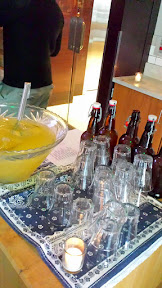

The Russian party concept is further reinforced as even before I can get past the first table, I am offered my first zakuski as a passed hors d’oeuvre, one not listed on the menu – it was some sort of fried dumpling, a kind of beef piroshky (or piroshki? I don’t know whether it’s an i or a y…).


Meanwhile, as you walk through the long room, you can admire the tchotchkes lining the small countertop on your rightside. Real Russian traditional tchotchkes – all random decorative trinkets like nesting dolls and wooden lacquered containers that you wouldn’t actually use because they are too pretty to function. Well, except for the tea-set you see there – you will actually see that used later tonight. I always get a kick out of the political nesting dolls with Yeltsin, Gorbachev, Brezhnev, and Stalin.


The various decorative tchotchkes all around are the epitome of the strange mix of the traditional Motherland Russia that are remnants of Imperial Russia, as well as the era of the red Soviet Union. Neither of these personify modern Russia and Union Soviet Socialist Republics, but they are still vivid memories and indelibly part of the culture now. On your left is an impressive DaNet ice sculpture. As you head towards the back, Soviet Union era posters are on the wall, as well as lots of candles and a few Russian cookbooks.

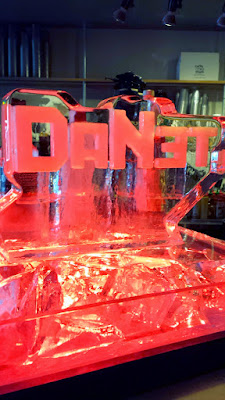


As you walk past the tables, look carefully for your assigned seats for your dining reservation, marked by a little sheet stating simply “xxx Party” at each of the designated seats.
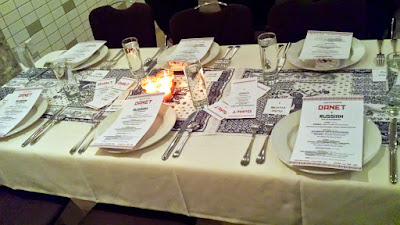

Peruse the menus at your seat – one sheet lists the whole dinner so you can begin to fortify yourself for the big meal that is about to come. While the dinner menu refers to one course of “zakuski”, a second menu sheet lists the bounty of what that zakuski actually consists of and you will see that this one “drinking foods” course is actually more like 5 appetizers! You should expect this, as seems to be a Russian custom, you will be served dishes and dishes of food until you are completely and uncomfortably full.
On the back of the dinner menu are a list of optional (at extra cost from the $75 set dinner price) beverages. Should you want to partake in vodka (highly recommended), they have flights of regular vodka, as well as infused vodkas such as horseradish dill vodka, or elderberry vodka. If straight vodka is a bit intimidating (you can choose to share among your dinner party of course), consider the cocktails as the mix of other liquids in the glass help round out the punch of vodka. You can also choose instead to have a matching wine pairing flight with each course. A server will come to your table to introduce herself or himself, and take your drink order.
The first course are the zakuski, which are traditional drinking foods – aka this is the perfect time to get your vodka on. I prefer the flavored vodkas, which I think is a middle ground between the straight vodka (but the more authentic experience) and the cocktails. It is expected that you take little sips of the vodka, and bites of your zakuski.
Chef Vitaly Paley was our guide throughout the night, ringing a little bell his mother had suggested in order to get everyone’s attention before introducing each course and describing the individual food items. I wish he could have talked longer as we were eating each item so I could look and see and think about each food item as he was telling us the history of it, and more about how it was made. To me, this felt like more than just a chef listing what food was on the menu for each course, but like a tour that we were taking to a country we were not familiar with, done via food. So I kept wanting to hear more, not much different from wanting to hear the tales of the old country from your parents or uncles or grandparents.

Meanwhile, kind Chef Paley seems worried about us being hungry and waiting during these intros to the courses (except for the kulebyaka, which is is super proud to tell us about and introduce us to) and tries to not draw our attention too long with him talking. So he goes over details pretty fast so listen up when he speaks! He’s done quite a few of these, yet still seems endearingly a bit nervous about the right amount of story to share. I understand a bit – he actually has a similar background to author Anya van Bremzen who wrote the memoir Art of Soviet Cooking I just read. He too, immigrated from the former Soviet Union and was a concert pianist, but then ended up turning to cooking and excelling in it at an international level (it is really weird that this is her exact story as well, though they come from different cities in former USSR. Not surprising to hear they are friends.). And from her memoir, it seems Russian immigrants have a complex love and hate relationship with the memory of the Soviet Union.
In fact, just look at the name of the popup overall, DaNet. Da means yes in Russian, and Net means no, so putting them together like DaNet (Да Нет) has a meaning of similar to “yes I agree, but no I also disagree, and even though you might think I am therefore neutral I disagree more than agree.” So the phrase together ultimately means no, a softer no than an outright no, and an illustration of the craziness of an everyday Russian phrase that uses two opposite words but still means something. Complicated, mixed feelings here! Anyway, on to the food recap!
First Course
On my dinner night, the zakuski included Solenya (Russian word for pickles), Ash roasted beet pkhali, Traditional Blini served with sour cream and dill, melted butter and seawater cured caviar (of course this was my favorite zakuski), Salade Olivier (a Russian salad with potatoes and vegetables and mayo and whose specific ingredients vary from family to family and is listed as one of the 1001 foods to die for, just like the Blini and Caviar dish). The acidity of the various types of Solenya (each one varying in sourness) were a great counterpoint to the richness of the heavier Salade Olivier and the rich Blini you assemble yourself. If you think you don’t like beets, try the ash roasted beet pkhali anyway as you may be surprised. The Blini pancakes are generously sized like medium pancakes!


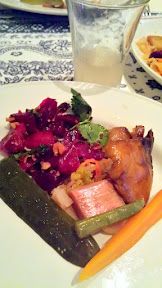

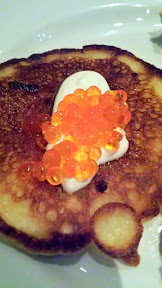

Nope, the list for the first course is still going, the zakuski also included buterbrodi, which are open faced sandwiches with butter and other toppings – we got four different kinds, of which I can no longer read my handwriting on what I wrote what they were – but all were delicious, and I have a little heart drawn next to the duck one (the one at the very top of the buterbrodi platter in the second photo – and the only one I got seconds of).

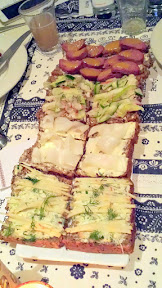

As the second bonus of the night already (still on course 1 of zakuski here), Chef Paley had brought some special garlic sausages from his last trip to New York, and generously shared it with us at the dinner, served with a bit of horseradish. I was having a hard time fitting everything on my plate!

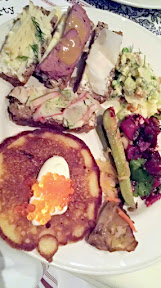
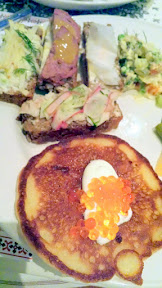
Second Course
Time for stew. For this dinner, it was Schi Bogatye and Kartorelkye Klyotski, a game broth and ash roasted cabbage stew with potato dumplings, with chives and herbs to add on top as garnish. The schi was served also with Buckwheat Rastegai (that bread with the hole at the top), and also Red Kraut Piroshki (those had no hole). The rastegai has an open center into which you traditionally could pour some of the stew – though in this case, it seemed the hole was too small for such an action.


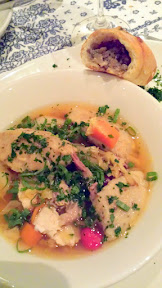
It may just seem like soup with some filled dumpling bread on the side, but that schi has great texture, lots of layers of flavors, and is quite filling. And there were lots of extra red kraut piroshki on the side too – make sure you add a little spoonful of that side of sour cream to the schi.
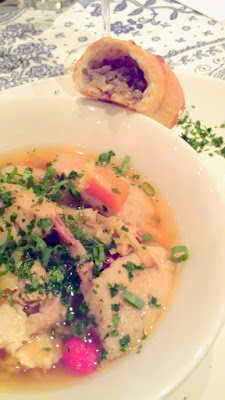
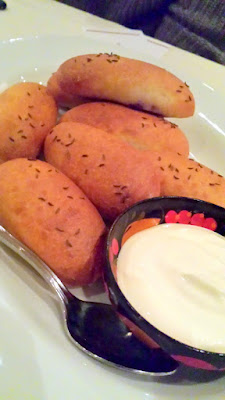
Third Course
Ooof, now time for the third course. I was already starting to get pretty full, but tried to soldier on with my comrades at my table. This was a significantly important dish. I know this because Chef Paley became Professor and proud host as he read to us from 1,000 Foods to Eat Before You Die: A Food Lover’s Life List about kulebyaka, as mentioned in multiple Russian literature and food books before the big presentation. Then the kulebyaka was presented at each table for guest admiration and photos before being cut up for individual plating.


I really wanted to take a photo as he was reading but felt bad about standing up to go to the kitchen area (only a few feet away), but thankfully Karen Brooks got up first, so I totally followed her. This is a really painstaking, ardous dish to make – Chef Paley confessed this took several days to prepare.
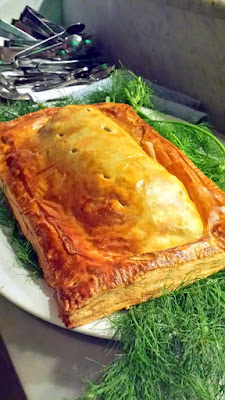
Tonight, the kulebyaka came as King Salmon with Sturgeon Cheek Porcini Pie with morel and sour cream dill sauce and viziga cracklings. The inside of the kulebyaka was fabulous, but I was hoping for more buttery goodness from the pastry after Chef Paley had read to us about how Anton Chekhov had described that
“the kulebyaka must make your mouth water, it must lie there before you – a shameless temptation…butter drips like tears, and the filling is fat, juicy, rich…”
So being a lover of butter, I really was looking for some more butter. Of course, I am also the type of person who empties the entire butter container when eating lobster with butter, and can eat radishes with little pats of butter. The morels were exquisite, and I saved and savored them dividing them carefully among my bites along with the accompanying heavenly roll your eyes back sauce (I wanted twice as much) and crispy viziga crackling.
The viziga is a very rare specialty, the spinal cord marrow of a sturgeon. I don’t know what trials were needed to extract this (since exact specifications were not detailed in historical recipes, and a dish this gourmet like kulebyaka or viziga would have been viewed as czarist and a target of Soviet class warfare). I don’t know what then further mysterious technique then would transform that gelatinous delicacy into these crackling vaguely reminiscent of the best lil nuggets of fried chicken skin… But it’s mouth magic.
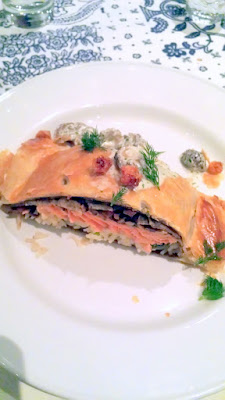

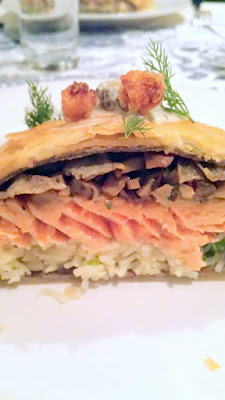

Fourth Course
After a little palate cleanser between the last and this course of Beryozovy sok, a birch sap (it tastes like water with a subtle sweet taste to it), came the dessert platters with tea service. The Chai black tea from Samovar comes with accompaniments like sugars and jam (!) to sweeten the tea.

Four desserts! I don’t know if I got all these names right, so forgive me:
- Baked Milk Ice Cream on a Stick (Toplyonoye Moloko Eskimo) – my favorite of the four
- Bird’s Milk Cookies (Ptychye Moloko)
- Rhubarb Jam Stuffed Donuts (Ponchiki S Varenyem)
- Chef Vitaly Paley’s mom’s Cacao and sour cream layer torte (Steopka)
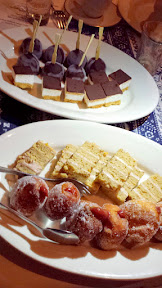
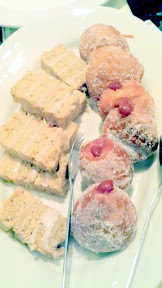

The final and last time my plate was full of an assortment of goodness – it started and ended that way.


You can make reservations now for DaNet, which it seems for the summer is scaled back to only popping up once a month – and June has already sold out 3 weeks ahead of time! To reserve your space for July or August, contact Imperial at (503) 228-7222. See the DaNet website for more details on dates.
If you have the opportunity, II really enjoyed the way that I set the experience up for myself- that is, making myself read the Art of Soviet Cooking before coming to this popup. Reading a bit before gave me a lot more context behind so many of the things I saw and ate (in particular, Anya has her first chapter in which she talks a great deal about kulebyaka). But, I also think this is a great Russian dinner experience even without the book. The communal adventure of sitting with others and meeting/talking with them while sharing dishes family style, together learning through the guide of Chef Paley, plus the expert technical culinary execution combined with the labor of love of this complicated food… This is a Russian party that you will be hard pressed to find unless you find some immigrant friends who are willing and able to spend so many days and so much time to create these all these dishes.
Have you had Russian food before?










